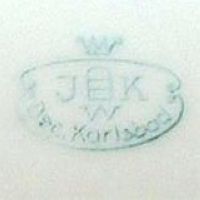
Image 010253-01-01
First mark used on self-made items between 1930 and 1945. Note the 'beehive' inclusion in this mark.
(Picture: Hans Brouwer)
I would like to thank both Nicolette and Sandra Kuba for their help that resulted in a total rewrite of this page. My thanks of course also go out to Hans Brouwer who not only greatly helped me but has an interesting Dutch hompage on Bohemian Porcelain. Without their help, this page would not have been possible and it once again shows that the so-called "reference books" (reprinted over and over again) should be used with extreme caution. Next to other obvious flaws, many books still incorrectly state that Kuba started business in 1900.
In 1930 the 1896 born Josef Kuba opened a small porcelain factory with its own little decoration studio in the city of Karlsbad (today Karlovy Vary, Czech Republic). During the Second World War, the area was overrun by German forces and remained occupied until 1945. Following the end of the war, Kuba re-established his decoration business in a building on Herbstweg road in the southern part of Wiesau (Bavaria). Since then, his work was mainly based on pieces from the Porzellanfabrik Carl Schumann factory in Arzberg (Bavaria) or the Heinrich & Co. factory in Selb (Bavaria) although he occasionally used items by other manufacturers, for example Hutschenreuther or Tirschenreuth. While Kuba decorated many items in a number of different styles like Alt-Wien ("Old Vienna") or Rembrandt, he preferred to include transfer applications based on oil paintings by the French artist Jean-Honoré Fragonard that mainly depict courting couples. With a little luck, one can also still find a few items with the rarely used Ätzgold, etched gold borders.
After the death of Josef Kuba in 1972 his son Horst Kuba continued business until he decided to close in 1989. The rectangular mark shown as Image 010253-02-02 for a long time was claimed to be the only mark used during this period, however the now also shown "HK" mark was verified via Sandra Kuba.
Note that before 1949 Kuba also used the additional brand name Imperial which should not be confused with other brands like the Imperial Carlsbad, Crown Imperial or Imperial Crown used by other companies. He also discontinued the use of the additional Bindenschild (often incorrectly dubbed "beehive") marking from around 1952 onwards; this however is only a rule-of-thumb as at least two items found with marks used after 1952 already had the 'beehive' mark already applied by the original manufacturer before Kuba started to work on them.
Also note that some people believe the initials JKW stand for Josef Kuba, Wiesau, however he used the JKW ever since he founded the business in Karlsbad, it originally stood for Josef Kuba Werkstätte and that the "W" later matched "Wiesau" was pure coincidence. The idea of it standing for the singular term "Werkstatt" is grammatically incorrect as the correct use in that case would have been "Werkstatt Josef Kuba", not the other way round.
Most marks applied by Kuba were so-called cover-up marks; please view the corresponding vocabulary entry by simply clicking on the highlighted term here if you need an explanation.

Image 010253-01-01
First mark used on self-made items between 1930 and 1945. Note the 'beehive' inclusion in this mark.
(Picture: Hans Brouwer)
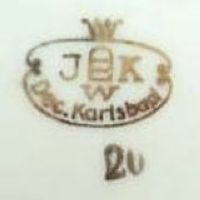
Image 010253-01-02
The same as before, this time in gold.
(Picture: Fran Kerbs)
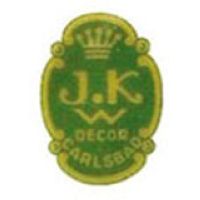
Image 010253-01-03
Used between 1930 and around 1945, identifyable through its thinner, taller shape.
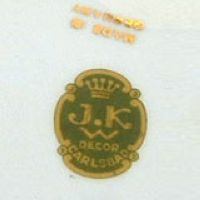
Image 010253-01-04
Intermediate mark stating "Made in Germany". "Bindenschild" present but cut off here due to picture size.
(Picture: Hans Brouwer)
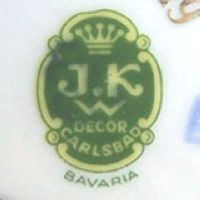
Image 010253-01-05
Used roughly between 1945 and around 1952. This is the enlarged "mark only" version for reference.
(Picture: Ginni D. Snodgrass)
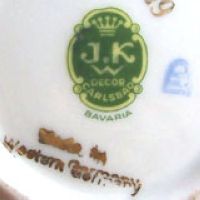
Image 010253-01-06
Previous picture showing the "Bindenschild" and "Made in Western Germany" addition.
(Picture: Ginni D. Snodgrass)
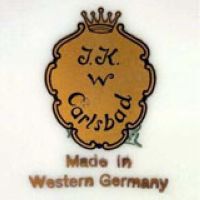
Image 010253-01-07
A rare version in gold, note the "Made in Western Germany".
(Picture: Fran Kerbs)
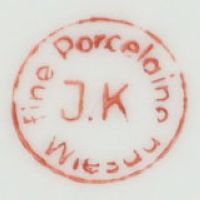
Image 010253-01-08
Used around 1950, here in red but can also be found in gold.
(Picture: Joyce Laws)
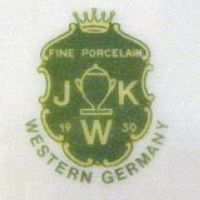
Image 010253-01-09
Used roughly between 1952 and 1972, one of the few marks which includes the founding date "1930".
(Picture: Chris Walter)
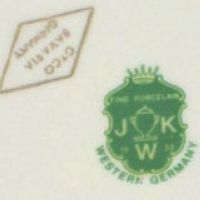
Image 010253-01-10
Same as before, here with a mysterious "OTCO Bavaria Germany" mark addition in gold.
(Picture: Fran Kerbs)
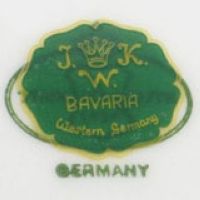
Image 010253-01-11
Used around 1969/1970, "Bavaria, Western Germany". Date based on the Tirschenreuth mark underneath that was not used earlier.
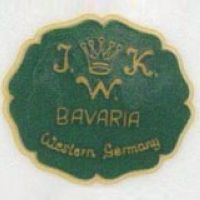
Image 010253-01-12
Another example of the previous mark, this time it completely covers the original mark.
(Picture: Fran Kerbs)
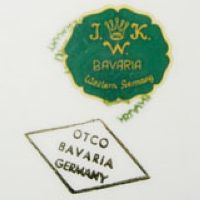
Image 010253-01-13
Again the same as before, but also with the mysterious "OTCO Bavaria Germany" mark in gold.
(Picture: Fran Kerbs)
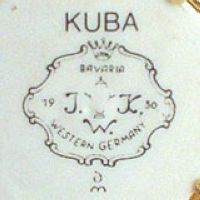
Image 010253-01-14
No date known, here a plain frame mark found on pendants decorated with small flowers.
(Picture: Fran Kerbs)
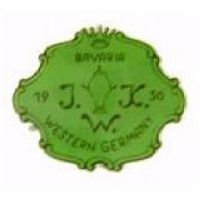
Image 010253-01-15
Same as before but this time as cover-up transfer-applied mark.
(Picture: Fran Kerbs)
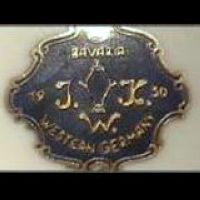
Image 010253-01-16
And finally a very nice paper sticker version (sorry for the quality of the picture).
(Picture: Fran Kerbs)
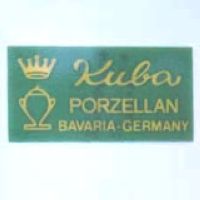
Image 010253-02-01
Used between 1972 and 1989, green cover-up mark with "Kuba Porzellan, Bavaria Germany".
(Picture: justeyen (JoAnn))
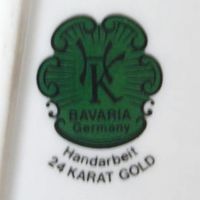
Image 010253-02-02
Used between 1972 and 1989, Hans Brouwer received this from Horst Kuba's daughter Sandra.
(Picture: Hans Brouwer)
© 2004-2026 C.S.Marshall, all rights reserved